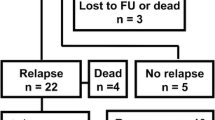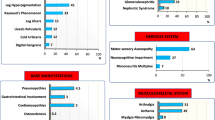Abstract
Type II mixed cryoglobulinemia (MC) is a systemic vasculitis, associated in most cases with hepatitis C virus (HCV) infection, sustained by proliferation of oligoclonal cells. Systemic B cell depletion and clinical remission can be achieved in non-Hodgkin lymphoma by human/mouse chimeric monoclonal antibody that specifically reacts with the CD20 antigen (rituximab). Similar effects could be expected in type II MC. Twelve patients, mean age 61.9 years (range 37–76), 11 with HCV infection genotype 2a2c (4 cases) or 1b (6 cases) and 3 (1 case) and symptomatic type II MC with systemic manifestations, including renal involvement, marrow clonal restriction, large necrotizing ulcers, and polyneuropathy, were considered eligible for rituximab therapy because of resistance or intolerance to conventional therapy or important bone marrow infiltration. Rituximab was administered intravenously at a dose of 375 mg/m2 on days 1, 8, 15, and 22. Two more doses were administered 1 and 2 months later. No other immunosuppressive drugs were added. Response was evaluated by assessing the changes in clinical signs, symptoms, and laboratory parameters. Levels of proteinuria, hematuria, erythrocyte sedimentation rate, cryocrit, rheumatoid factor, and IgM decreased while C4 values increased and HCV viral load remained stable during short- and medium-term observation. Bone marrow abnormalities were found to reverse to normal. Constitutional symptoms disappeared or ameliorated. No acute or delayed side effects were seen. Based on this experience and a number of reports published in the last 5 years, Rituximab appears to be a safe and effective therapeutic option in symptomatic patients with HCV-associated MC with signs of systemic vasculitis.


Similar content being viewed by others
References
Brouet JC, Clauvel JP, Danon F, Klein M, Seligmann M (1974) Biological and clinical significance of cryoglobulins. A report of 86 cases. Am J Med 57:775–778
Meltzer M, Franklin EC, Elias K et al (1966) Cryoglobulinemia, a clinical and laboratory study. II. Cryoglobulins with rheumatoid factor activity. Am J Med 40:837–856
Gorevic PD, Kassab HJ, Levo Y et al (1980) Mixed cryoglobulinemia: clinical aspects and long-term follow-up of 40 patients. Am J Med 69:287–308
D’Amico G, Colasanti G, Ferrario F, Sinico RA (1989) Renal involvement in essential mixed cryoglobulinemia. Kidney Int 35:1004–1014
Pascual M, Perrin L, Giostra E, Schifferli JA (1990) Hepatitis C virus in patients with cryoglobulinemia type II. Infectious Dis 162:569–575
Durand JM, Lefevre P, Harle JR et al (1991) Cutaneous vasculitis and cryoglobulinemia type II associated with hepatitis C virus infection. Lancet 337:499–500
Casato M, Taliani G, Pucillo L et al (1991) Cryoglobulinemia and hepatitis C virus. Lancet 337:449–453
Misiani R, Bellavita P, Fenili D et al (1992) Hepatitis C virus infection in patients with essential mixed cryoglobulinemia. Ann Intern Med 117:573–577
Ferri C, Longombardo G, La Civita L et al (1992) Hepatitis C virus, autoimmune liver disease and cryoglobulinemic hepatitis. J Hepatol 16:242–243
Agnello V, Chung RT, Kaplan LM (1992) A role for hepatitis C virus infection in type II cryoglobulinemia. N Engl J Med 327:1490–1495
Ferri C, Monti M, La Civita L et al (1993) Infection of peripheral blood mononuclear cells by hepatitis C virus in mixed cryoglobulinemia. Blood 82:3701–3704
Invernizzi F, Pioltelli P, Cattaneo R et al (1979) A long-term follow-up study in essential cryoglobulinemia. Acta Haematol 61:93–99
Tarantino A, De Vecchi A, Montagnino G et al (1981) Renal disease in essential mixed cryoglobulinemia. Long term follow-up of 44 patients. Q J Med 50:1–30
Monti G, Galli M, Invernizzi F et al (1995) Cryoglobulinemias: a multi-centre study of the early clinical and laboratory manifestations of primary and secondary disease. GISC. Italian Group for the Study of Cryoglobulinemias. QJM 88:115–126
Rieu V, Cohen P, Andrè MH et al (2002) Characteristics and outcome of 49 patients. Rheumatology 41:290–300
Tarantino A, Campise M, Banfi G et al (1995) Long-term predictors of survival in essential mixed cryoglobulinemic glomerulonephritis. Kidney Int 47:618–623
Roccatello D, Fornasieri A, Giachino O et al (2007) Multicenter study on HCV-related cryoglobulinemic glomerulonephritis. Am J Kidney Dis 49:69–82
Roccatello D, Isidoro C, Mazzucco G et al (1993) Role of monocytes in cryoglobulinemia-associated nephritis. Kidney Int 43:1150–1155
Ferri C, Mascia MT (2006) Cryoglobulinemic vasculitis. Curr Opin Rheumatol 18:54–63
Fornasieri A, Li M, Armelloni S et al (1993) Glomerulonephritis induced by human IgMk–IgG cryoglobulins in mice. Lab Invest 69:531–540
Roccatello D, Morsica G, Picciotto G et al (1997) Impaired hepatosplenic elimination of circulating cryoglobulins in patients with essential mixed cryoglobulinemia and hepatitis C virus (HCV) infection. Clin Exp Immunol 110:9–14
Pileri P, Uematsu Y, Campagnoli S et al (1998) Binding of hepatitis C virus to CD81. Science 282:938–941
Roccatello D, Giachino O, Fornasieri A (2000) Forum multidisciplinare su “la sindrome HCV”. G Ital Nefrol 6:654–665
Zignego AL, Giannelli F, Marrocchi ME et al (2000) T [14 18] translocation in chronic hepatitis C virus infection. Hepatology 31:474–479
Maloney DG, Grillo-Lopez AJ, White CA et al (1997) IDEC-C2B8 (Rituximab) anti-CD20 monoclonal antibody therapy in patients with relapsed low-grade non-Hodgkin’s lymphoma. Blood 90:2188–2195
Shan D, Ledbetter JA, Press OW (1998) Apoptosis of malignant human B cells by ligation of CD20 with monoclonal antibodies. Blood 91:1644–1652
Byrd JC, White CA, Link B et al (1999) Rituximab therapy in Waldenstrom’s macroglobulinemia: preliminary evidence of clinical activity. Ann Oncol 10:1525–1527
Levine TD, Pestronk A (1999) IgM antibody-related polyneuropathies: B-cell depletion chemotherapy using Rituximab. Neurology 52:1701–1704
Saleh MN, Gutheil J, Moore M et al (2000) A pilot study of the anti-CD20 monoclonal antibody rituximab in patients with refractory immune thrombocytopenia. Semin Oncol 27:99–103
Zecca M, De Stefano P, Nobili B, Locatelli F (2001) Anti-CD20 monoclonal antibody for the treatment of severe, immune-mediated, pure red cell aplasia and hemolytic anemia. Blood 97:3995–3997
Zaja F, De Vita S, Mazzaro C et al (2003) Efficacy and safety of rituximab in type II mixed cryoglobulinemia. Blood 101:3827–3834
Zaja F, Russo D, Fuga G et al (1999) Rituximab for the treatment of type II mixed cryoglobulinemia. Haematologica 84:1157–1158
Della Rossa A, Tavoni A, Baldini C, Bombardieri S (2002) Treatment of chronic hepatitis C infection with cryoglobulinemia. Curr Opin Rheum 13:231–237
Misiani R, Bellavita P, Fenili D et al (1994) Interferon alfa-2a therapy in cryoglobulinemia associated with hepatitis C virus. N Engl J Med 330:751–756
Johnson RJ, Gretch DR, Couser WG et al (1994) Hepatitis C virus-associated glomerulonephritis. Effect of alpha-interferon therapy. Kidney Int 46:1700–1704
Rossi P, Bertani T, Baio P et al (2003) Hepatitis C virus-related cryoglobulinemic glomerulonephritis: long-term remission after antiviral therapy. Kidney Int 63:2236–2241
Manns MP, McHutchison JG, Gordon SC et al (2001) Peginterferon alfa-2b plus ribavirin compared with interferon alfa-2b plus ribavirin for initial treatment of chronic hepatitis C: a randomised trial. Lancet 358:958–965
Lindsay KL, Trepo C, Heintges T et al (2001) A randomized, double-blind trial comparing pegylated interferon alfa-2b to interferon alfa-2b as initial treatment for chronic hepatitis C. Hepatology 34:395–403
Selby P, Kohn J, Raymond J, Judson I, McElwain T (1985) Nephrotic syndrome during treatment with interferon. Br Med J 290:1180
Janessen H, Brouwer J, Van der Mast RC, Schalm S (1994) Suicide associated with alpha-interferon therapy for chronic viral hepatitis. J Hepatol 21:241–243
Ferri C, Pileri S, Zignego AL (2000) Hepatitis C virus, B-cell disorders, and non-Hodgkin lymphoma. In: Goedert JJ (ed) Infectious cause of cancer. Target for intervention. Humana, Totowa, pp 349–368
Roccatello D, Mazzucco G, Coppo R et al (1991) Immune material processing by phagocyte cell system in cryoglobulinemia. Clin Nephrol 36:114–126
Margin S, Craxi A, Fabiano C et al (1994) Hepatitis C viraemia in chronic liver disease: relationship to interferon alpha or corticosteroid treatment. Hepatology 19:273–279
Roccatello D, Baldovino S, Rossi D et al (2004) Long term effects of anti-CD20 monoclonal antibody treatment of cryoglobulinemic glomerulonephritis. Nephrol Dial Transplant 19:3054–3061
Looney RJ (2002) Treating human autoimmune disease by depleting B cells. Ann Rheum Dis 61:863–866
Arzoo K, Sadeghi S, Liebman HA (2002) Treatment of refractory antibody mediated autoimmune disorders with an anti-CD20 monoclonal antibody Rituximab. Ann Rheum Dis 61:922–924
Treon SP, Anderson KC (2000) The use of rituximab in the treatment of malignant and non-malignant plasma cell disorders. Semin Oncol 27:79–85
Clynes RA, Towers TL, Presta LG, Ravetch JV (2000) Inhibitory Fc receptors modulate in vivo cytotoxicity against tumor targets. Nat Med 6:443–446
Sansonno D, De Re V, Lauretta G et al (2003) Monoclonal antibody treatment of mixed cryoglobulinemia resistant to interferon alfa with an anti-CD20. Blood 101:3818–3826
Conflict of Interest
There are no conflicts of interest to declare.
Author information
Authors and Affiliations
Corresponding author
Rights and permissions
About this article
Cite this article
Roccatello, D., Baldovino, S., Rossi, D. et al. Rituximab as a Therapeutic Tool in Severe Mixed Cryoglobulinemia. Clinic Rev Allerg Immunol 34, 111–117 (2008). https://doi.org/10.1007/s12016-007-8019-0
Published:
Issue Date:
DOI: https://doi.org/10.1007/s12016-007-8019-0




